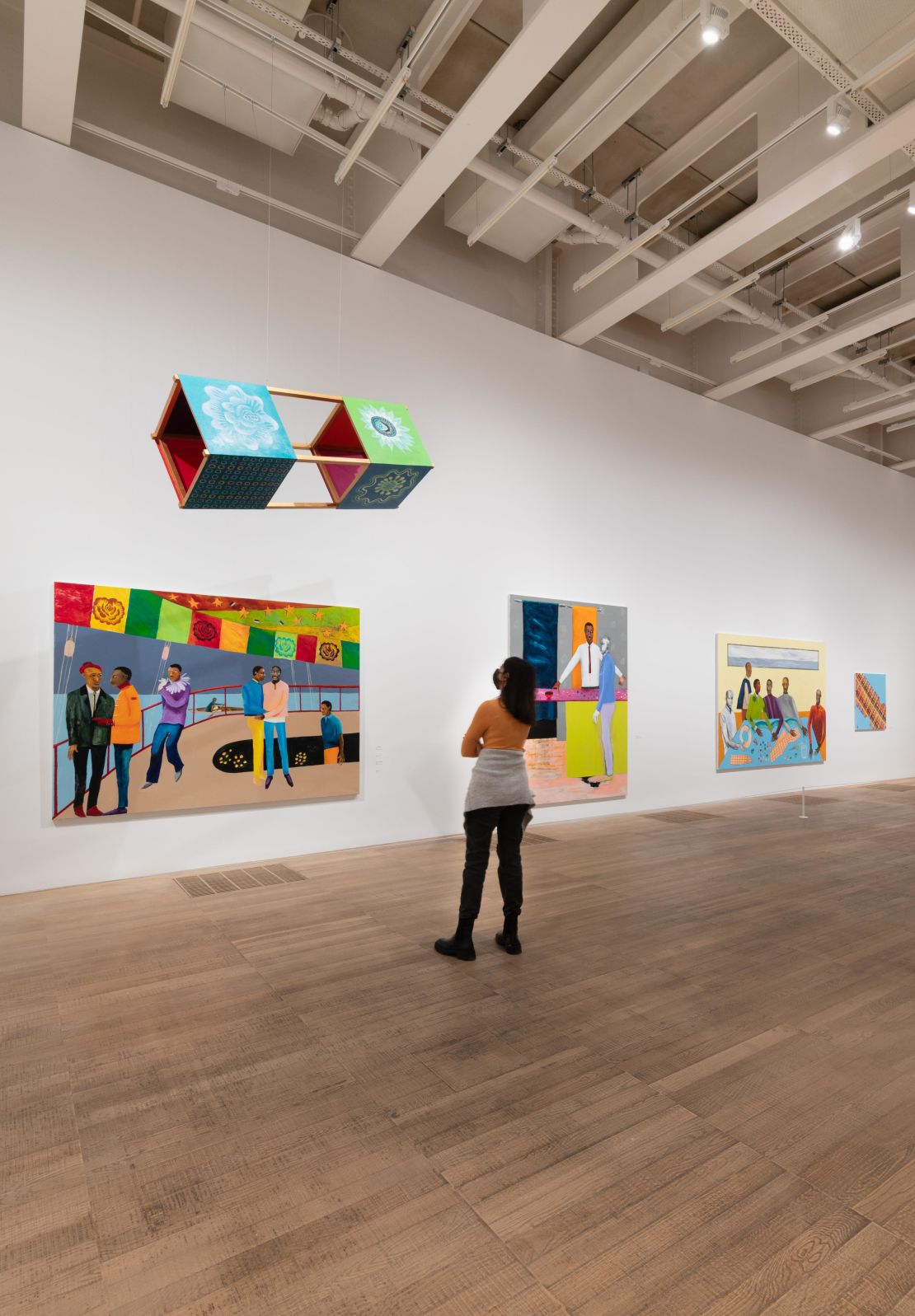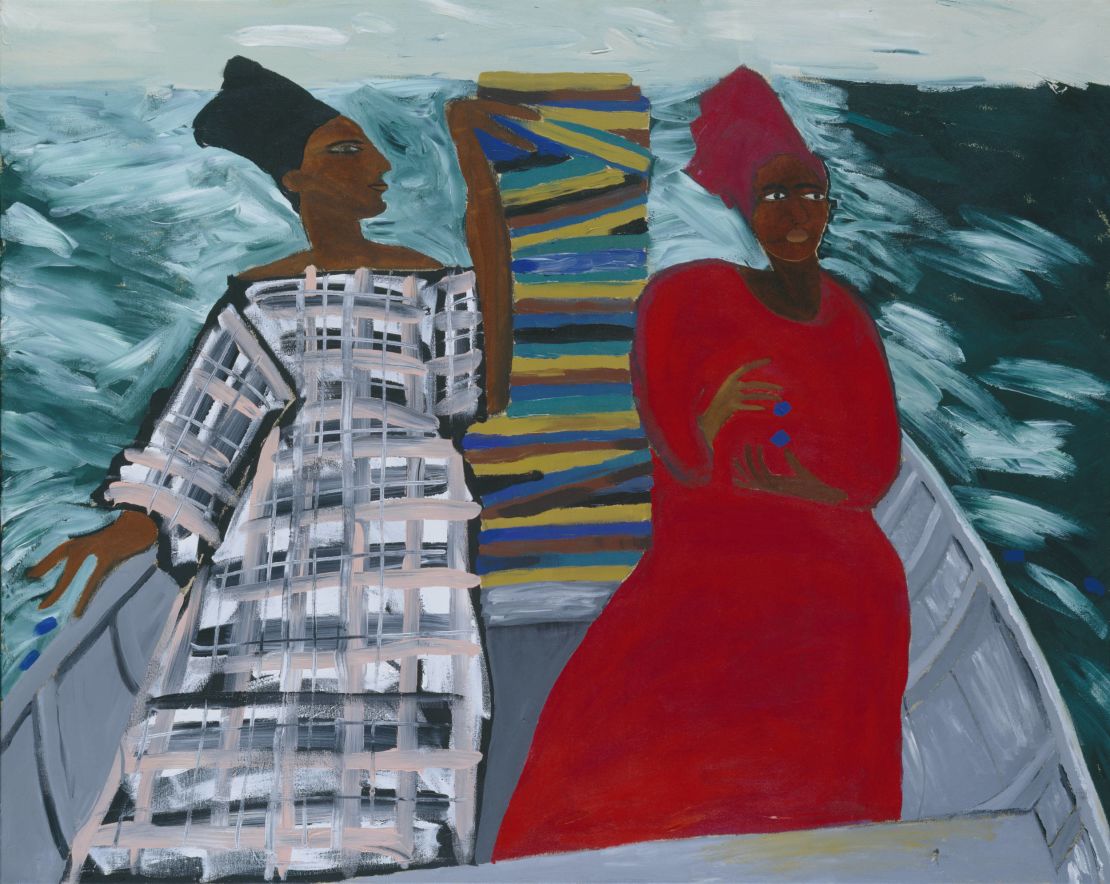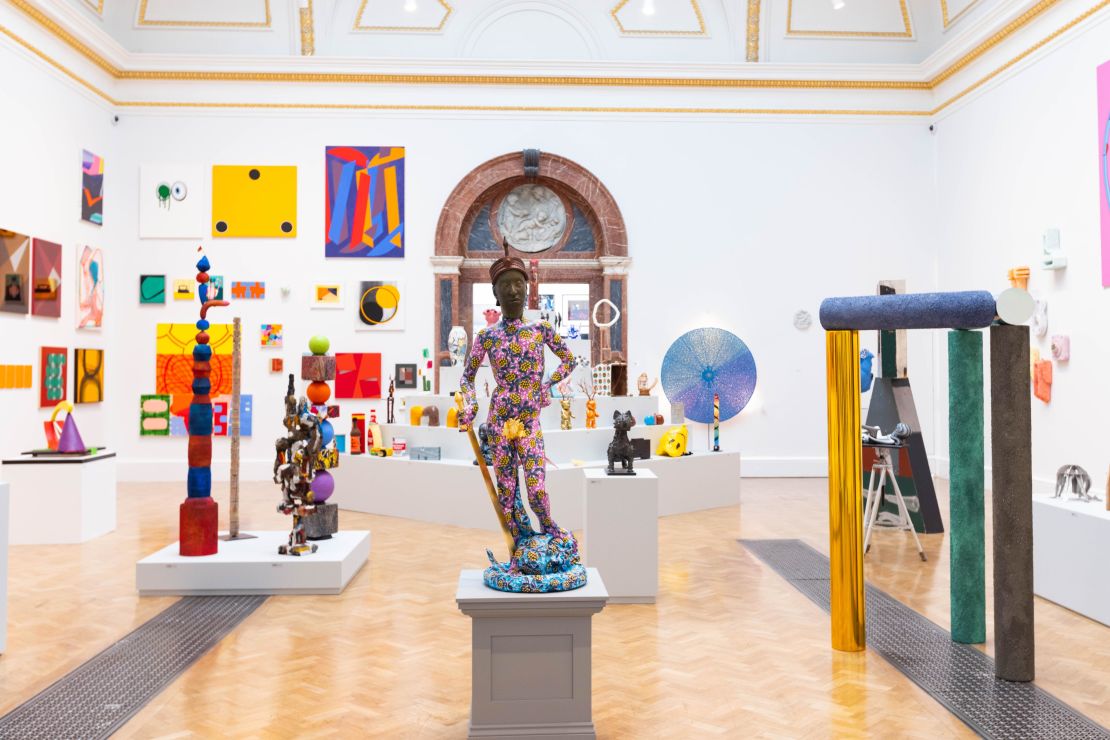In April 1819 a French slave ship called “Le Rodeur” departed West Africa for the Caribbean. On board were 22 crew, and around 160 enslaved Africans. In the cramped conditions aboard the ship, a debilitating disease broke out, rendering all the slaves and many of the crew blind. The French captain, calculating that his human cargo was worth more as an insurance payout, ordered weights to be attached to the feet of 36 enslaved Africans, who were thrown into the Atlantic Ocean.
It’s not immediately obvious, standing in a large gallery space in London’s Tate Modern, that the series of paintings by Lubaina Himid titled “Le Rodeur” speak to this horrifying incident. Her colorful images do not show a ship of enslaved people, but figures from different times, arranged in surreal scenes, such as a disjointed ball on the ship’s deck.
“I guess the most important thing in this painting is that nobody knows what’s happening,” said Himid, looking at her works, which give off an air of uncertainty. “These people come from all sorts of different eras, but they’re feeling the vibrations of that trauma,” she explained. “Those reverberations are still shaking us up in the room now, today.”

‘Filling in the gaps in cultural history’
Five years ago Himid, who was born in Zanzibar, an archipelago off the coast of Tanzania, and moved to the UK as a baby with her British mother, became the first Black woman to win the prestigious British art award the Turner Prize. She has been exploring colonial legacies and fighting for Black representation in the arts her whole career. “I suppose what I’m trying to do is fill in the gaps in art history and fill in the gaps in cultural history,” she said.
Now, aged 68, Himid is back with a headline show at one of the UK’s biggest galleries.
While drawing on deep and painful themes, Himid’s work, as in “Le Rodeur,” is often understated in its subversion. Next to a giant sculpture of planks resembling a wave, with a recording of the sounds of the sea filling the air, is one of the paintings from her “Revenge” series from the 1990s. Azures of the sea and colorful shades from the dresses of the two women sat in a small boat pop from the canvas. This is “Between the Two My Heart is Balanced.”
Art historian Mora Beauchamp-Byrd points out how Himid’s painting is based on the 1877 work “Portsmouth Dockyard.” Where James Tissot’s original depicts a White British soldier sat between two female companions, Himid replaces the man with two Black women – a couple.

Beauchamp-Byrd believes that subverting and reframing colonial and gender narratives is part of Himid’s craft. ”I see this real studied engagement with art history,” she said. ”There’s a kind of rigor there … in terms of thinking about art from the past, but also in terms of really biting satire, that speaks to larger issues around diaspora and colonialism.”
Creating a dialogue
Himid’s exhibition comes as another headliner exploring colonialism and championing Black representation concludes. Across London, the 2021 Summer Exhibition at the Royal Academy was curated by celebrated British Nigerian artist Yinka Shonibare. He says it was the most diverse show in the 250 years of the institution. For three months, at the entrance to the gallery, a statue of its founder Joshua Reynolds greeted visitors, draped for the occasion in a colorful sash of African batik fabric.
Memories of a painful past echoed in the exhibition’s first room, which featured a collection of paintings and drawings by Bill Traylor. Born in the 1850s, Traylor was among the last generations of enslaved African Americans, and taught himself to paint and draw after gaining his freedom. “I wanted to have his work as the kind of starting point and the inspiration for the entire project … [he] was a self-taught artist, and he depicted his own community,” explained Shonibare. “The drawings are absolutely fascinating.”
In another room, one of Shonibare’s own works stood out – a sculptural figure wrapped head to toe in the artist’s signature Dutch wax fabric, or at least, up to the neck. The head of the sculpture was entirely different; a bronze Ife head, thought to date back to 15th century Nigeria. The intricate craftsmanship of the head was shocking to the first Europeans to view it a century ago, Shonibare said.

”When the sculpture was discovered in Nigeria,” the artist explained ”a Western anthropologist suggested that the Africans would not have made a work that beautiful in bronze – that’s something that Donatello would have made, the Italian Renaissance artists.” Poking fun at Eurocentric judgements of African art, Yinka placed the Ife head atop the classical body of a replica of Donatello’s statue “David.”
Shonibare has also used his platform as a celebrated artist to bring new and diverse voices into the art world. He began years ago by opening his studio in East London to emerging artists to show their work. Now, he is working to create a residency space in Lagos, Nigeria. ”I wanted to create a dialogue between artists from all over the world – Europe, Asia – with artists in Africa,” he explained. More recently, he created a collection of 50 sculptures, sold to help fund a fellowship for young artists of color at London’s upcoming V&A East arts museum.
The dialogue is already beginning at the Royal Academy, where the Summer exhibition played host to many emerging artists from Africa – with work from Ghanaian artist Amoako Boafo (who partnered with Dior in 2020) and Eddy Kamuanga from the Democratic Republic of Congo taking pride of place.
For Beauchamp-Byrd, who two decades ago curated a start-up exhibition on the work of Britain’s diasporic artists, major solo exhibitions such as Lubaina Himid’s at the Tate have been a long time coming. ”It feels like these artists are finally getting the recognition that they deserve,” she said.
Himid is also carefully optimistic: “Many things have changed, lots of things haven’t,” she said. “I think there’s a lot more listening going on. British institutions are listening more to what we’re saying.”
“Lubaina Himid” will be at Tate Modern, London until July 3 2022.














